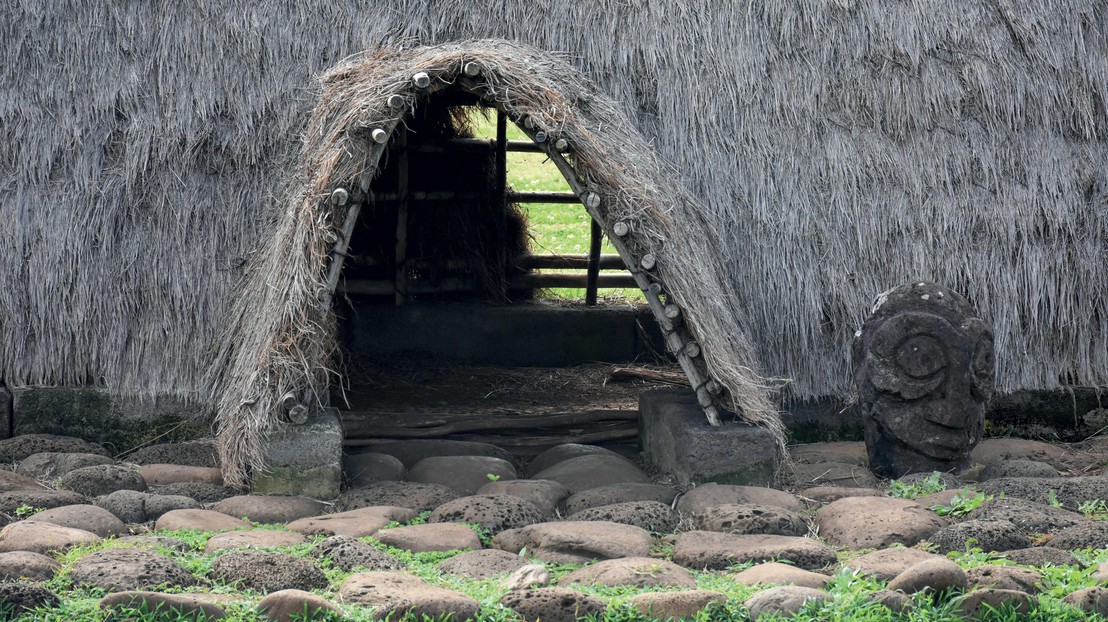
The entryways into hare paenga were delineated with smooth, oval stones. 2024 EPFL/Chloé Joly-Pottuz - CC-BY-SA 4.0
For her PhD in architecture at EPFL, Chloé Joly-Pottuz researched construction methods, and in particular those for timber structures on Easter Island.
When people think about Easter Island, it's probably for its majestic moai stone sculptures. It's certainly not for the small community that lives there, although the island's 8,600 residents face particularly challenging living conditions: volcanic soil that's been stripped bare by deforestation, gusting winds and some 120,000 tourists who flock to the island each year.
Scientists at EPFL's Laboratory of Construction and Architecture, headed by Prof. Paolo Tombesi, have been studying Easter Island since 2018 for exactly these reasons. It offers a perfect microcosm for examining the various stresses on an isolated region that has limited resources and that's dependent on Chile administratively and on tourism for its economy.
For her PhD in architecture, Chloé Joly-Pottuz researched construction methods, and in particular those for timber structures. She spoke with the island's residents to see how their experience from the recent past could be used to shape new approaches. She also looked at ancient living structures such as hare paenga, which were built during the same period as ahu, or the ceremonial stone platforms on which moaï statues were erected, probably between 1200 and 1600. As part of her research, she made three trips to Easter Island, including to the Puku Manu Mea interpretive center at the Vaihu archeological site in the southern part of the island. Within the center, researchers have built a replica of an ancestral village.
Modern-day interpretation
"Paenga, or rectangular blocks of basalt, served as the foundation for hare paenga," says Joly-Pottuz. "The blocks were laid to create a large ellipse on the ground and were partly embedded. The upper surface of the blocks contained holes into which flexible tree branches were placed to support the roof, essentially a canopy of vegetation. The entryways into hare paenga were delineated with smooth, oval stones called poro, which marked the boundary between light and darkness, between the land and sea. They were placed in a semicircle in front of the tunnel-like entrance into the living structures."
Another interesting aspect is the modern-day interpretation of these structures: "They were probably the early form of today's taupea, which are the covered galleries used in modern dwellings, similar to the verandas found on colonial homes," says Joly-Pottuz.
Forming a bond between local resources and cultural significance
Hare paenga are an example of the symbiotic relationship among local resources (construction materials), functional homebuilding and cultural significance. Can such a relationship still be found on Easter Island? "Today, most houses are built from a very short list of standardized components that may not always be available," says Joly-Pottuz. "What's more, the materials are often expensive and of mediocre quality - resulting in homes with a negative environmental impact owing to their type, which leads to a low population density, and their unsustainable design." What's more, today's construction methods, based largely on lightweight wooden materials, aren't really suited to the context of Easter Island.
However, some aspects of the island's architecture show that its people are seeking to affirm their cultural identity. "During my visits to the island, I noticed certain aspects common to local homes that suggests the link between local resources, construction efficiency and cultural significance is in flux," says Joly-Pottuz. "For instance, several houses today have sculptured, and sometimes varnished, tree trunks beneath the taupea. They are crafted from local trees and are more of an artistic expression than an architectural or structural requirement. This suggests the people of Easter Island are looking for a modern architectural identity - one that also evokes their Polynesian heritage, as this is the region of the world to which they belong."






